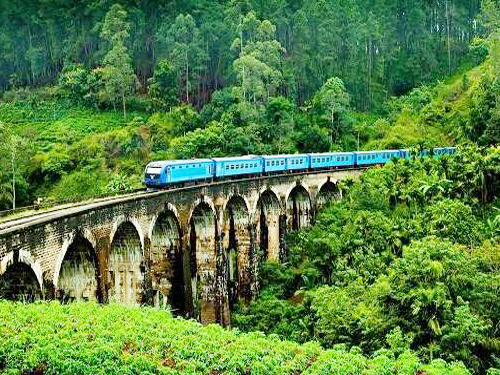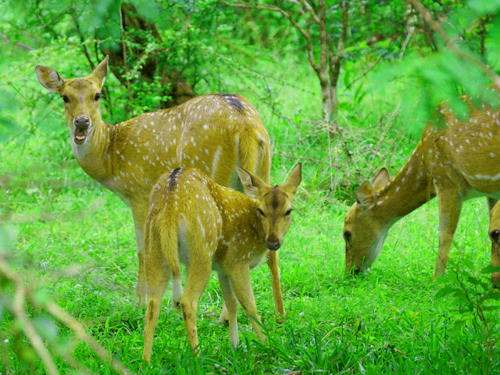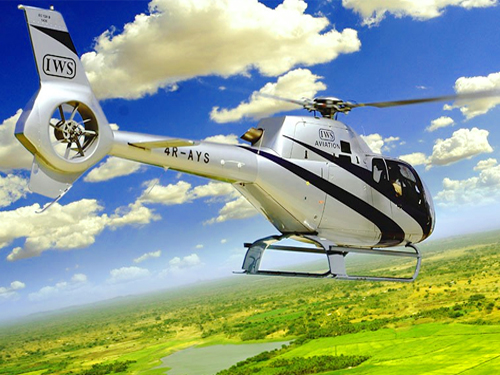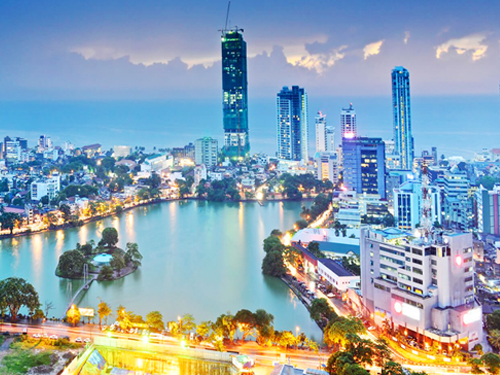Wilpattu in Sri Lanka
Wilpattu, located 30km west from Anuradhapura, spans the border between North Central and North Western Province. It borders the ModeragamAru in south and Kala Oya north. The Indian Ocean is to the west. It is located at 8o 12' – 8o 32’-N, 79o 52’ – 80o 10’ E and covers an area of 131.693 hectares. Topography can vary from 152 masl to mean sea level. Katz (1974) has extensively researched the geomorphological, geological, and other features of Wilpattu National park.
It experiences an average annual temperature of 27.20 C, and receives approximately 1,000 mm of rainfall each year. The park experiences a predominant climatic situation. It is characterized by inter-monsoonal rains from March to April and a dry spell that lasts from May through September. The Northeast monsoon influences the rainy season from September to December.
The main geographic feature of the Park is made up of Villu wetlands as well as ancient irrigation tanks within the WilpattuNps. These Villus look like lakes but they are actually basin-like depressions that contain rain water. Due to their soil characteristics and seepage of saline water, two of these Villus are salinized. Many species of flora are found in the western sector of Wilpattu's dense forests. Three types of vegetation can be found in the western sector of Wilpattu: Littoral vegetation includes salt marsh and low scrub directly adjacent to the beach, and further inland, Monsoon forest, with tall emergents such as Weera (Drypetesebenum), Ebony (Disopyrospennum)and Wewarna(Alseodaphnesmecapriflolia).
Eisenberg (1972) and Lockhart (1972) recorded 31 species of mammals in the WNP. This protected area is home to the endangered mammals, including the Elephant (Elephasmaximus), Sloth bears (MelursusUrsinus), and Leopards (PantheraPardus). Barrette (1991) has studied the presence of large numbers of Spotted Deer scattered in the park. In the past, WNP has not adequately documented other animal groups. Over three decades ago, Eisenber g. Lockhart (1972), pioneered a study that documented valuable ecological information about Wilpattu National Park.
King Vijaya, a clan leader, and the first settlers selected fertile lands in the Modara Ganga floodplains and Kala Oya flood plains to establish their settlements and grow crops. Prehistoric man used the beaches and areas surrounding the "Vila", or natural lakes, as hunting grounds and settlement grounds. This area was home to an ancient civilization. However, the archaeological evidence is sparse. The park and its immediate environs have been the subject of a lot of legends and history.
TammannaNuwara is believed to be located between Kudiramalaya and ModeragamAru mouth. This is where Prince Vijaya was said to have landed in 600 BC and established the Sinhalese civilisation. Vijaya and his companions may have landed here, and then rest by putting their hands on the ground. Modern soil surveys show a reddish strip running north-south along the western coast belt that rose from the sea level millions of years ago. Legend has it that Vijaya married Kuveni the Yaksha princess, whose palace is now a ruin at Kali Vila. GalbendiNeeravia is north-east of Maradanmaduwa Tank and is believed to be where Prince Saliya, a son of King Dutugamunu lived with Asokamala (Samaraweera 1970).
The survey covered 68 sites that were considered to be important archaeologically .Twelve sites were either suggested by local villagers or mentioned in the literature, but were not visited due inaccessibility or lack of information. Based on the artifacts found at each site, Fossil sites are divided into five main categories: Prehistoric sites and Historic monastery sites, Fossil sites, Prehistoric, Prehistoric, and Pro-historic sites. Irrigation or agricultural areas can also be included. You can further divide Prehistoric sites into Palaeolithic, Mesolithic stone tool and Proto-historic locations. Megalithic burials and Black and Red Ware sites (BRW) can also be sub-divisions. The survey team was able to find evidence of at least two archaeological finds from each of the five periods at several sampling sites
On February 27, 2005, the park, which was closed for almost 20 years due to civil war in Sri Lanka, was reopened. The war caused a lot of damage to the area. Parts of the frontline ran through the park or close to it for a significant amount of time. The management of the park was greatly disrupted and many animals and staff suffered as a result. The park infrastructure and management have been restored and wildlife is nearly back to normal.
There are roughly 34,000 people who live in 135 settlements within the immediate vicinity of Wilpattu. Their main income sources are coastal fishing, livestock rearing in the north and southern, but mostly rain-fed agriculture. Although there are some drawbacks to living near a national park, such as the animals eating the crops and other issues, it has many advantages such as the job opportunities available in the tourism sector. Wilpattu has a Community Outreach Program that works closely with local residents to address these problems. Visit the Wilpattu Park to learn about the typical lives of those who live in the buffer areas of Wilpattu. This is a great place to start your Sri Lankan experience.
WilpattuRamsar Wild land Cluster. 02/02/2013, North Western, North Central Provinces; 165 800 ha; 08o32’27"N 080o10’01"E. National Park. This site includes all of Wilpattu's National Park, which was established in 1938. The park's boundary contained 205 water bodies, man-made and natural. One of the most distinctive features is the 'villus', which are natural, sand-rimmed water reservoirs that cover a range between 10 and 160 hectares. They are then filled with rainwater. The varied salt content of the Villus provides an ideal habitat to a variety of migratory and resident wildlife species.
These include the endangered Asia Elephant Elephasmaximus, LeptoptilosJavanicus and Crocodyluspalustris, a freshwater crocodile. The area is rich in biodiversity thanks to its mangroves, seagrass beds, salt marshes and swamps. The site has been home to 21 endemic species, including the endangered Sri Lankan Leopard Panthherapardus (ssp. Kotiya and the Ceylon Swallow, Hirundohyperythra. It was once home to a flourishing agricultural civilization as evidenced by the 68 archaeologically significant sites. The western and southeastern areas of the site rely heavily on subsistence and commercial fisheries while others rely upon agriculture. The site is threatened by invasive aquatic species, logging, and slash-and-burn agriculture. Ramsar Site no. 2095. The most recent RIS information: 2013.
Wilpattu provides shelter for many species flora. The Wilpattu National park's flora is more diverse than the rest and helps support much of its wildlife. In 2006, the World Conservation Union (IUCN), released a survey that listed six hundred and twenty three flowering plant species from one hundred and twenty-3 plant families. Twenty-seven of these plants were considered endemic, while twenty-one were listed as threatened.
The western half of Wilpattu is covered in dense forests, meadows and grasslands. There are also a few water bodies that provide water. Three types of vegetation can be found here. Near the shoreline, you will find coast vegetation such as salt marsh and low scrub, as well monsoon forest with tall emergent. About 70% of Wilpattu National park is covered with deciduous thorn shrub and dry evergreen forest, with different heights depending upon soil quality. Floods are more likely in the rainy season when the villu is not surrounded by grasslands.
Wilpattu has 621 plant species. The large Palu tree (ManilkaraHexandra) can be seen in the forest. You will also find permanent and seasonal rivers, as well as irrigation systems up to 2,000 year old. The beach is surrounded by coastal salt marshes. One of Sri Lanka's largest mangrove forests is found in the Kala Oya estuary. The shallow sea supports artisanal fishermen and has beds of seagrass, which provide food for the globally endangered Dugong.
The Wilpattu National Park is home to typical dry zone climax forest. There are three distinct vegetation types: a continuous 20m-30m tree canopy, a sub canopy up to 15m, shrubs and herbs upto 5m. The trees are densely arranged in well-developed sites where there is poor growth of herbaceous and shrubby forms. This layer contains the leaves of plant species.
Can be classified as microphyllous and mesophyllous, with typical dry zone habitat characteristics. Exposure to the ground is quite common, and forest regeneration can often be seen in many locations. However, there were several types of DEF that were identified in the field.
This type of vegetation can be spread in a very small area, such as in conjunction with minor streams. It can also be found in areas as small as 10m in the flat areas at the lower reaches. The vegetation height is approximately 15-25m, with a close canopy belt of trees. You can also distinguish sub-canopy (0.5m-3m) and shrub/herb layers. It is more like a rainforest because of its general luxuriance in comparison to other forests. Lianas, which are a significant component of the forest framework, have a high level of floristic richness and are an important part. Only a few deciduous species, such as TerminaliaArjunaMadhucalongifolia, TerminaliaArjuna and Diospyrosmalabarica, are found along the banks of perennial stream banks. These species' evergreen nature can be attributed the endless availability of groundwater throughout each year.
Riverine forests are the link between streams and terrestrial habitats. They provide protection against stream bank erosion caused by water currents. The banks are protected by the thick root systems of shrubs and trees. The Kala Oya Riverine Forests and ModeragamAru provide a safe haven for birds, bats, reptiles and amphibians.
Flood plains in National Park refer to the relatively flat area bordering Kala oya, which experiences flooding every year during the north-east monsoon season. The severity of a flood will determine how much land is inundated. The dominant hydrological input is the rivers and streams that overflow with water. This has a significant impact on the flora. Flooding can cause flooding.
Flood plains' soil surfaces are temporarily covered by water from rivers or feeder streams. The silt that is deposited during this process is the main source for nutrients to flood plain habitat. Forested land covers the majority of vegetation and is made up of species that are able to withstand water currents as well as periodic flooding. Floodplain habitat is composed of forests with similar structure and composition to riverine forests. The forest canopy is quite closed, and it is about 20-30m high. You can also distinguish sub-canopy (12m), shrub/herb (0.5m-3m) layers. Large patches of grass can be seen, however, unlike the riverine forests.
These small bodies of stagnant water are often shallow enough to allow sunlight to reach the bed. Some of these are man-made. They have clearly visible water outlet channels, which is unlike Villus. The body of water is also surrounded by a narrow belt wetland vegetation. These sub habitats are associated with the WNP stream network. There are several sub habitat types that can be identified. These develop due to changing hydric conditions towards central water bodies. Such as
- Occasionally/seasonally flooded edge forest.
- Occasionally/seasonally flooded dry land grassland.
- Seasonally flooded damp grassland.
- Swamp community.
- Marsh community.
- Lentic community.
The edge forest is closed vegetation, while the rest are open habitats. Although they have the same structure and species composition as riverine forests, edge forests are also rich in species from nearby dry zone forests. The forest canopy is nearly closed, with a height range between 20m and 30m. The sub-canopy measures approximately 15m. A layer of shrub/herb (0.5m-3m), can also be identified. They are lusher than dry mixed evergreen forests. There will be variations in the habitats depending on the topography of each site. This could include changes in the structure or composition. In relation to the annual fluctuating water levels, habitat structure, species dominance, and species composition are highly variable.
WNP's most distinctive landscape unit is the Villu wet Villu grassland habitat. It can be found in shallow natural depressions within the landscape. Villus can be oval or circular in shape and have no outlets for water accumulation. The terrain slopes very little from the edges to the center. It is often less than 10 degrees. In response to fluctuating water levels, many vegetation zones or belts have been established at the edges and centers of the water bodies.
Coastal and marine ecosystems
Mangroves
Mangroves are woody plant assemblages that can tolerate salt and are found along estuaries and sheltered lagoons. Mangroves that are well-developed can reach heights of 5-10m, although some species like Sonneratiaalba and Rhizophoramucronata can grow higher. The stratification of mature mangrove stands is restricted to a single layer, which forms a dense canopy. Mangroves possess unique structural features that allow them to survive in extreme conditions such as low water levels, thick mud, waterlogged soils, clays with a high amount of organic matter, and daily fluctuations of salinity. They include a variety of a natomical or physiological features, such as stilt roots and prop roots or knee root for anchorage e.gBruguieracylindrica.
Pneumatophores (breathingroots) are used for respiration e.g. Sonneratia alba - succulent leaves for water storage e.g.ExcoecariaAgalloch a - the ability to remove excess salt leaves e.g. Rhizophoramucronata, shiny leaves for light reflection Lumnitzeraracemosa is a viviparous method for seed germination. Rhizophoramucronata, Ceriopstagal Mangrove mixed communities are not only Mangrove stan.ds. Some patches also have back mangrove species. Excoecariaracemosa and Lumnitzeraracemosa
Salt marshes
Saltmarsh is an intertidal community of plants that are dominated by herbs up to 0.25m and low-growing shrubs up to 1.5m. The structural distinction between saltmarsh (or mangroves) and saltmarsh is clear. Mangroves is an intertidal ecosystem dominated by trees. These sites can become very dry in the long-term.
The dry season (April-August) is when salinity increases. Sometimes crystallized salt can be seen. These habitats are home to perennial herbs like Salicornia brachiate or Suaedamaritima, which cover the ground with upright and prostrate shoots. The ground is generally 75% bare soil with sedges like Cynodondacylo n or Cyperusspp. They can also be found intermixed. Salt marshes can be found in a variety of environments, including dry conditions, high soil salinity, salt spray, persistently high temperatures, and excessive evaporation. These conditions are not conducive for the growth of other species. Salt marshes are also an important habitat for coastal birds.
Sand dunes and beaches
In the park's western section, the beach vegetation can be found at places that slope gently towards the ocean. The extent of the shore's steepness and ground stability will determine the physiognomy of the beach flora, as well as the composition of minor sand dunes. The vegetation is found in the area beyond the direct impacts of waves and tides. It supports a tree canopy (4m-6m), scattered creepers (0.25m), and small shrubs (1m). These help to consolidate the soil and reduce wind-induced erosion. They also provide resistance to the removal of sand from occasional seawater. Stuntedness is a characteristic of trees that is caused by strong winds, salt spray, and insolation. The beach vegetation zone can extend up to 50m depending on the slope and width of the shore.
Fauna of Wilpattu National Park
During the survey period, Wilpattu National park (WNP), recorded 284 faunal species from 101 families. There were 21 species that are endemic, and 30 species that are nationally endangered. A proportional representation analysis revealed that birds were the most abundant group of vertebrates (39%) while amphibians were 4 %.
There are 31 mammal species that call at home, including the Sri Lankan elephant (Elephas max), sloth bears (Melursusindus), leopard (Pantheraperduskotiya), and the water buffalo (Bubalusbubalis). Reptiles, such asrat snakes, Indian python, common cobra, mugger crocodile, pond turtle and soft shelled turtleand you can also find many species of birds here, including several species of birds ,includes garganey (Anasquerquedula), pin tail (Anasacuta), whistling teal (Dendrocygnajavanica), spoonbill (Platalealeucorodia), white ibis (Threskiornismalanocephalus), large white egret (Egretta alba modesta), cattle egret (Bubulcus ibis) and purple heron (Ardeapurpurea).
Birds in Wilpattu National Park
Wilpattu is a paradise for birders. They will be able spot a variety of birdlife. Many migratory and resident wetland bird species are found in the lakes surrounding the park. Wilpattu is home to the endemic brown-capped bat (Pellorneumfuscocapillusbaaulti), the Ceylon grey hornbill, Ocycerosgingalensis (Ocycerospompadora), the little-ringed plover(Charadriusdiubiusjerdoni), the racket-tailed bulbul (Dicrurusmelanicterus), the golden-backed woodpecker and the spot-bellied-owlensis). The common migrant birds that are often viewed at Wilpattu include the Indian paradise flycatcher (Terpsiphoneparadis), the orange-headed ground plover (Zootherafulva), the Ceylon grey hornbill (Ocycerosgingalensis), the small-billed drongo (Dicrurusmelanicterus), the large white egretta (Egrettaalabamodesta), the cattle egret, the jaffi), the Indian darter (Anogaster) and the Indian darter (Anipalensionis melanogaster).
The Wilpattu lakes are also home to the white-shafted littletern (Sterna albus), the whiskered terns (Chlidoniashybridus), the gull-billed terns (Gelochelidonviridistris), the Indian paradise flycatcher (Terpsiphone paradise), the great stone-curlews (Esacusrecorvirostris), the cattle egret (Bubulcus ibis), the crested hawk etuscirrhatus), and the etusetusetusetus), the etuscirrhatusetusetusetusetuscirrhatusetusetus), the etusetusetusetus s) and the etus (Spizaetus melanogaster). You should also be on the lookout for ground-feeding birds such as the Sri Lankan jungle fowl (Gallus lofayetii) and the pavocristatus (Pavocristus). The latter is the national bird in Sri Lanka.
Marine mammals of Wilpattu National Park
There are fifteen (15) marine mammals that have been recorded in the Ramsar boundary, Kalpitiya sanctuary area, and the Kandakuliya/Talawila area. Recent sightings of Blue Whale (Balaenopteramusculus), and Bryde’s Whale (Balaenopteraedeni), have been confirmed.
A 1000+ population of Spinner Dolphins (Stenellalongirostris), also lives in the area, migrating between slope and continental shelf. This area also saw the recoding of rare Rough-toothed Dolphins (Steno bredanensis). In recent years, the Kalpitya area saw an unusually high number of Sperm whales (Phystermacephalus) around 200+.
Leopard (Pantheraparduskotiya)
The leopard is Sri Lanka's top predator and can be found in almost all types of forests, including thorn scrub, dry deciduous forests, lowland rain forests, and mountain forests. The leopard, which weighs between 37 and 90 kg for males, and between 28 and 60 kg for females in Sri Lanka, is endangered by habitat loss and poaching and is listed as a threatened species through the IUCN (2007).
Asian Elephant (Elephasmaximusmaximus)
The Sri Lankan elephant is a subspecies of the Asian elephants in India and Thailand. It is one of the most accessible Big 5 species. There are many elephant safaris available in all natural parks. The gentle giant's calm demeanour, indomitable determination and contrasting personality have made it a beloved natural world icon. Although there were 10 of them in Sri Lanka at the beginning of the century only about 5,000 remain in the wild today. The "Human-Elephant Conflict", which sees 150-200 elephants die each year, is the main reason for the IUCN Red List listing of the elephant as endangered.
Sloth Bear (Melursusursinus)
The Sri Lankan Sloth Bear, which is the only species of bear found in Sri Lanka, is a remarkable subspecies to the Indian elephant. Although the wild population of the Sloth can be as low as 1,000 in some isolated areas, it is still listed as "vulnerable" by the IUCNRed list. The most serious threat to the sloth's existence is destruction of dry-zone natural forests. Sloths are the most difficult of the Big 5, and organized efforts will be required to save them.
Other Mammals in Wilpattu National Park
- Spotted Deer (Axis axis)
- Barking Deer (Muntiacusmuntjak)
- Mouse-deer (TragulusNigricans)
- Wild Boars (Susscrofa)
- Water Buffalos (Bubalusbubalis)
- Mugger Crocodiles (Crocodyluspalustris)
- Ceylon Junglefowl (Gallus lafayetii)
- Brown-capped Babbler(Pellorneumfuscocapillus)
- Black-naped Monarch (Hypothymisazurea)
- White-rumpedShama (Copsychusmalabaricus)
- Ruddy Mongoose (Herpestessmithii)
- Indian Grey Mongoose (Herpestesedwardsii)
- Purple-faced Langur (Trachypithecusvetulus)
- Sri Lankan Grey Horbill (Ocycerosgingalensis)
- Oriental Dwarf Kingfisher (Ceyxerithaca)
- Greater Thick-knee (Esacusrecurvirostris)
- Pin-tail Snipe (Gallinagostenura)
- Indian Rock Python (Python molurus)
Butterflies in Wilpattu National Park
Wilpattu is home to many butterflies, making it an excellent spot for lepidopterists. The Ceylon lesser albatross(Appias Paulina) is a white butterfly that gathers in giant numbers shut to water puddles.Colourful butterflies observed around the park include the blue Mormon (Papiliopolymnestor), the Common Mime (Papilioclytia), Common Banded Peacock (Papiliocrino),Great Orange Tip (Hebomoiaglaucippe), Common Jay (Graphiumdoson), Large SalmonArab (ColotisFausta), Dark Wanderer (Pareroniaceylanica), Great Egg Fly (Hypolimnasbolina), Indian Sunbeam (Curetisthetis), Redspot Duke (DophlaEvelina) and the tawnyrajah (CharaxesBernardus).
Reptiles at Wilpattu
Wilpattu is home to many reptiles. Wilpattu is home to the land monitor (VaranusBengalensis). However, other species can be discovered consisting of the mugger crocodile(Crocodyluspalustris), estuarine crocodile (Crocodylusporosus), pond turtle (Melanonchelystrijuga) and the soft-shelled turtle (Lissemyspunctata) in addition to star tortoises(GeocheloneElegans) which can be discovered on the grasslands.There are a few snake species present at Wilpattu such as the frequent cobra (Najanaja),rat snake (Ptyasmucosus), Indian python (Python molurus), common Bronzeback(Dendrelaphistristis), frequent bridal snake (Dryocalamusnympha), Indian Russell's viper(Daboiarusselii), Forsten's cat snake (Boigaforsteni), endemic flowery wolf snake (Lycodonosmanhilli) and the endemic Sri Lankan flying snake (Chrysopeleataprobanica).
About Safari in Wilpattu National Park
Wildlife safaris can be enjoyed in Wilpattu National park all year. It is best to visit during the dry season from May to September and early October, when wildlife viewing in and around the many wells becomes more intense. The reserve is lush and green from October to December due to the north eastern monsoon. This brings great numbers of butterflies, which are a highlight of the beginning of the year. The intoxicating fruits from the palu trees are a favorite food of sloth bears, so sightings at this time are ideal. You will be able to see wildlife best in the morning and evening so get up early.
Best time to visit Wilpattu National Park
Wildlife safaris can be enjoyed in Wilpattu National park all year. It is best to visit during the dry season from May to September and early October, when wildlife viewing in and around the many wells becomes more intense. The reserve is lush and green from October to December due to the north eastern monsoon. This brings great numbers of butterflies, which are a highlight of the year. The intoxicating fruits from the palu trees are a favorite food of sloth bears, so sightings at this time are ideal. You will be able to see wildlife best in the morning and evening so get up early.
How to go Wilpattu National Park
Wilpattu can be found 30 km north of Puttalam (approximately180 km north of Colombo). It stretches from the northwest coast inland to the ancient capital city Anuradhapura (50km to the east) and covers an impressive 425 sq mi. The route from Colombo is via Negombo, Chilaw and Puttalam, with a turn-off at the little hamlet of Thimbiriwewa near the 28th mile post along the Puttalam-Anuradhapura road. Hunuwilgama is 8 km away from the turn-off. Here you can get a permit or a guide. You can also fly by helicopter and take off from either the Bandaranaike Airport, Ratmalana or Wilpattu. You can then drive to the Park from there. This location is not accessible by air taxi.
Safari Time in Wilpattu National Park
- Morning Safari (6.00am)
- Afternoon Safari (2.30pm)
- Full day Safari
Type of Safaris in Wilpattu National Park
A jeep safari is a great way to explore Wilpattu. A number of safari tour companies provide jeeps, drivers, and professional publications to ensure a safe, educational, and informative tour. Because they know the best places for fauna, the guides will ensure that you spend your time in the parks. They are experts at finding wildlife between the bushes, and can ensure that safety precautions are followed.
You can choose from a full-day or a half-day safari. You can arrange tours according to your preferences. Half-day tours can be either in the morning (6 to 11 am) or at night (3 to 6 pm). Half-day safaris can easily be sighted most animals, but true nature lovers will enjoy the full-day safari which allows them to experience nature at a slower pace. A full-day safari takes approximately 12 hours of driving. Travelers will only be able to visit 25% of the park's dense forest since 75% of it is covered by trees. Although the park is well-connected with roads, it can be quite bumpy.
Dolphin Beach organizes excursions to Wilpattu. This includes transportation to and from the park to and back, ranger fees and park entrance fees. Taxes are included. Refreshments and lunch can be provided if necessary. We only work with reputable safari tour companies that provide expert-guided tours in safe, well-maintained jeeps with professional rangers and drivers. The Jeep can hold up to six people.

 Safe Travels
Safe Travels Français
Français Deutsch
Deutsch עִברִית
עִברִית Italiano
Italiano Nederlands
Nederlands Polski
Polski Pусский
Pусский Español
Español














































